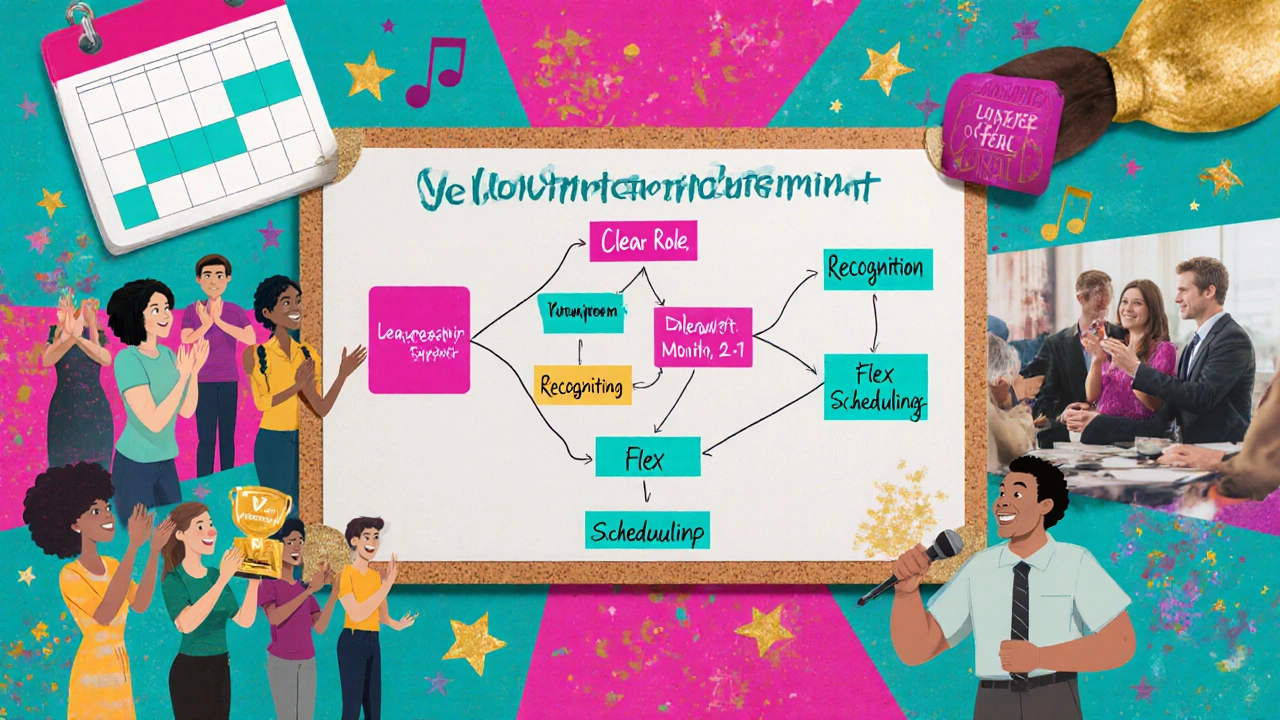Why Volunteers Quit: Top Reasons & How to Keep Them Engaged
 Oct, 17 2025
Oct, 17 2025
Volunteer Retention Impact Calculator
Calculate Your Volunteer Retention Impact
See how implementing key retention strategies can reduce turnover based on nonprofit research data
Expected Results
When a volunteer walks away, the loss is felt by the whole team. Volunteer turnover is the rate at which volunteers stop serving an organization, and it can cripple projects, raise costs, and sap morale. Understanding why volunteers quit is the first step toward fixing the problem.
Quick Takeaways
- Clear expectations and realistic time commitments prevent early drop‑off.
- Recognition, training, and growth opportunities keep enthusiasm high.
- Regular feedback loops, like exit interviews, reveal hidden pain points.
- Flexibility in scheduling and role design reduces burnout.
- Strong leadership support ties volunteers to the organization’s mission.
1. Misaligned Expectations - The Silent Turnoff
Most volunteers sign up with a vague idea of what they’ll do. When the actual tasks differ, disappointment sets in fast. A 2023 study by Volunteer Canada found that 42% of volunteers left within the first three months because the role didn’t match what they were told during recruitment.
To avoid this, write a concise role description that lists:
- Primary duties
- Time commitment (hours per week, peak periods)
- Skill level needed
- How the role contributes to the broader mission
Share the description during the interview and ask the candidate to repeat it back. This simple check confirms understanding and reduces early churn.
2. Volunteer Burnout - When Passion Turns Into Exhaustion
Burnout isn’t just a corporate problem. Volunteer burnout is a state of chronic emotional and physical fatigue caused by overwhelming responsibilities, lack of support, or repetitive tasks. A 2022 survey by Idealist reported that 37% of volunteers felt “over‑extended” and considered quitting.
Key burnout triggers include:
- Unrealistic workloads
- Never‑ending deadlines
- Little or no appreciation
Mitigation tactics:
- Rotate duties every few months to keep work fresh.
- Offer short, focused training sessions that improve efficiency.
- Schedule regular “check‑in” meetings to gauge stress levels.
3. Lack of Recognition - The Unseen Value Gap
Everyone likes to feel seen. Recognition programs such as volunteer of the month, thank‑you cards, or public shout‑outs on social media can boost morale dramatically. In a 2024 nonprofit benchmark, organizations that publicly recognized volunteers saw a 28% lower turnover rate.
Effective recognition should be:
- Timely - acknowledge contributions within days, not months.
- Specific - mention exact actions (“Your fundraiser raised $5,000”).
- Personal - match the reward to the volunteer’s interests (e.g., a gift card to a favorite coffee shop).
4. Insufficient Training and Onboarding - Setting Up for Failure
Imagine being dropped into a kitchen without a recipe. Training and onboarding are the recipe cards for volunteers. Without them, volunteers waste time figuring out basics on the fly, leading to frustration.
Best‑practice onboarding checklist:
- Welcome packet with mission statement, code of conduct, and contact list.
- Hands‑on demo of tools or processes they’ll use.
- Mentor assignment for the first 30days.
- Quick quiz to confirm understanding.
Even a 30‑minute “boot camp” can cut early quit rates by half, according to a 2023 Harvard Business Review case study featuring a regional food bank.
5. Rigid Scheduling - When Life Gets in the Way
Volunteers aren’t full‑time staff; they juggle jobs, families, and studies. Scheduling flexibility-allowing shift swaps, remote participation, or occasional stand‑by roles-keeps people from feeling trapped. A 2021 experiment by a youth mentoring program let volunteers pick any two days per month; turnover dropped from 35% to 18%.
Practical steps:
- Use an online calendar that lets volunteers sign up for slots that suit them.
- Offer micro‑volunteering tasks that can be completed in under an hour.
- Allow volunteers to pause their service for a defined period without penalty.
6. Weak Leadership Support - The Missing Safety Net
Volunteers thrive under leaders who listen, empower, and model the organization’s values. Leadership support includes regular coaching, clear communication, and visible commitment to volunteer well‑being. In a 2022 Global Volunteer Survey, 61% of volunteers said they would stay longer if they felt leaders cared about their input.
How to demonstrate support:
- Host quarterly town‑hall meetings where volunteers can voice concerns.
- Provide a clear escalation path for issues (e.g., a dedicated volunteer manager).
- Celebrate volunteer stories in internal newsletters.
7. No Exit Interview - Missing the Feedback Goldmine
When a volunteer leaves, many organizations simply say goodbye. Conducting a brief exit interview-even a 5‑minute phone call-uncovers patterns you can act on. Common insights include “tasks felt repetitive” or “I didn’t know how my work impacted the community.”
Sample exit interview questions:
- What initially attracted you to this role?
- Which tasks did you enjoy most and least?
- Did you feel adequately supported?
- What could have kept you longer?
Log answers in a simple spreadsheet; track recurring themes and adjust policies accordingly.

8. Disconnect from Mission - When Volunteers Forget the Why
People give their time to feel part of something bigger. If day‑to‑day activities feel detached from the organization’s mission, volunteers lose purpose. A 2024 case study of an environmental cleanup group showed that adding a quarterly “impact briefing” (photos, metrics, stories) reduced quit rates by 22%.
Tips to strengthen mission connection:
- Share impact metrics after each project (e.g., “We planted 1,200 trees”).
- Invite volunteers to meet beneficiaries or community members.
- Highlight personal stories that illustrate the mission’s ripple effect.
Putting It All Together - A Retention Blueprint
When you address the eight factors above, you build a robust retention strategy that turns occasional helpers into long‑term ambassadors. Below is a concise checklist you can print and hang in your volunteer office.
| Area | Action | Frequency |
|---|---|---|
| Role clarity | Publish detailed descriptions & confirm understanding | At recruitment |
| Burnout monitoring | Conduct short stress surveys | Every 2 months |
| Recognition | Public shout‑outs & small rewards | Monthly |
| Training | Hands‑on onboarding + quarterly refreshers | First week & quarterly |
| Scheduling | Offer flexible slots & micro‑tasks | Ongoing |
| Leadership support | Quarterly town‑halls & open‑door policy | Quarterly |
| Exit interviews | 5‑minute phone call or survey | At departure |
| Mission connection | Share impact stories & metrics | After each project |
Next Steps for Volunteer Managers
- Audit your current volunteer program against the checklist above.
- Pick two high‑impact changes to implement within the next 30days (e.g., add a recognition board and schedule flexibility).
- Gather baseline data on turnover (monthly quit rate, average tenure).
- After 90days, compare the numbers - you should see a dip in quits and longer average tenure.
Small, data‑driven tweaks can make a huge difference in keeping volunteers happy and engaged.
Frequently Asked Questions
What is the most common reason volunteers quit?
Misaligned expectations - when the actual duties, time commitment, or support differ from what was promised during recruitment.
How often should I recognize volunteers?
Aim for timely recognition: a quick thank‑you after each task, a monthly spotlight for outstanding effort, and an annual celebration event.
Can flexible scheduling really reduce turnover?
Yes. Programs that let volunteers choose slots or contribute in micro‑tasks see turnover rates drop by 15‑30% compared to rigid schedules.
What should I ask in an exit interview?
Focus on motives: why they joined, what they liked, pain points, support perception, and suggestions for improvement. Keep it short and respectful.
Is volunteer burnout a real problem?
Absolutely. Studies show over a third of volunteers experience burnout, which directly leads to quitting. Address it with workload limits, breaks, and recognition.